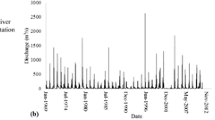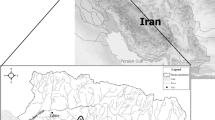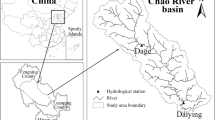Abstract
The main purpose of this study is to construct a new hybrid model (PSR–ANN) by combining phase space reconstruction (PSR) and artificial neural network (ANN) techniques to raise the accuracy for the prediction of daily river flow. For this purpose, river flow data at three measurement stations of the USA were used. To reconstruct the phase space and determine the input data for the PSR–ANN method, the delay time and embedding dimension were calculated by average mutual information and false nearest neighbors analysis. The presence of chaotic dynamics in the used data was identified by the correlation dimension methods. The results of the PSR–ANN, pure ANN and gene expression programming (GEP) models were inter-compared using the Nash–Sutcliffe and root-mean-square error criteria. The inter-comparisons showed that the proposed PSR–ANN method provides the best prediction of daily river flow. Moreover, the ANN model showed higher ability than the pure GEP in estimation of the river flow.






Similar content being viewed by others
References
Abarbanel HDI, Brown R, Kadtke JB (1990) Prediction in chaotic nonlinear systems: methods for time series with broadband Fourier spectra. Phys Rev A 138:1782
Awchi TA (2014) River discharges forecasting in northern Iraq using different ANN techniques. Water Resour Manag 28:801–814
Baydaroglu O, Kocak K (2014) SVR-based prediction of evaporation combined with chaotic approach. J Hydrol 508:356–363
Bayazıt M (1988) Hydrologic models. ITU, Istanbul
Elshorbagy E, Simonovic SP, Panu US (2002) Estimation of missing stream flow data using principles of chaos theory. J Hydrol 255:123–133
Ferreira C (2001a) Gene expression programming in problem solving. In: 6th online world conference on soft computing in industrial applications (invited tutorial)
Ferreira C (2001b) Gene expression programming: a new adaptive algorithm for solving problems. Complex Syst 13(2):87–129
Fraser AM, Swinney HL (1986) Independent coordinates for strange attractors from mutual information. Phys Rev A 33(2):1134–1140
Ghorbani MA, Kisi O, Aalinezhad M (2010) A probe into the chaotic nature of daily streamflow time seriesby correlation dimension and largest Lyapunov methods. Appl Math Model 34:4050–4057
Grassberger P, Procaccia I (1983) Characterization of strange attractors. Phys Rev Lett 50(5):346–349
Hasanpour Kashani M, Daneshfaraz R, Ghorbani MA, Najafi MR, Kisi O (2015) Comparison of different methods for developing a stage-discharge curve of the Kizilirmak River. J Flood Risk Manag 8:71–86
He Z, Wen X, Liu H, Du J (2014) A comparative study of artificial neural network, adaptive neuro fuzzy inference system and support vector machine for forecasting river flow in the semiarid mountain region. J Hydrol 509:379–386
Huang SC, Chuang PJ, Wu CF, Lai HJ (2010) Chaos-based support vector regressions for exchange rate forecasting. Expert Syst Appl 37:8590–8598
Islam MN, Sivakumar B (2002) Characterization and prediction of runoff dynamics: a nonlinear dynamical view. Adv Water Resour 25:179–90
Jayawardena AW, Fernando DAK (1995) Artificial neural networks in hydrometeorological modelling. In: Proceedings of the fourth international conference on the application of artificial intelligence to civil and structural engineering-developments in neural networks and evolutionary computing in civil and structural engineering, Cambridge, UK
Kalteh AM (2013) Monthly river flow forecasting using artificial neural network and support vector regression models coupled with wavelet transform. Comput Geosci 54:1–8
Kazem A, Sharifi E, Hussain FK, Saberi M, Hussain OK (2013) Support vector regression with chaos-based firefly algorithm for stock market price forecasting. Appl Soft Comput 13:947–958
Kennel M, Brown R, Abarbanel HDI (1992) Determining embedding dimension for phase-space reconstruction using a geometrical construction. Phys Rev A 45:3403–3411
Khatibi R, Ghorbani MA, Hasanpour Kashani M, Kisi O (2011a) Comparison of three artificial intelligence techniques for discharge routing. J Hydrol 403:201–212
Khatibi R, Ghorbani MA, Aalami MT, Kocak K, Makarynskyy O, Makarynska D, Aalinezhad M (2011b) Dynamics of hourly sea level at Hillarys Boat Harbour, Western Australia: a chaos theory perspective. Ocean Dyn 61:1797–1807
Khatibi R, Sivakumar B, Ghorbani MA, Kisi O, Kocak K, FarsadiZadeh D (2012) Investigating chaos in river stage and discharge time series. J Hydrol 414:108–117
Kisi O (2008) River flow forecasting and estimation using different artificial neural network technique. Hydrol Res 39(1):27–40
Kisi O, Cimen M (2011) A wavelet-support vector machine conjunction model for monthly streamflow forecasting. J Hydrol 399:132–140
Kisi O, Moghaddam Nia A, GhafariGosheh M, JamalizadehTajabadi MR, Ahmadi A (2012) Intermittent streamflow forecasting by using several data driven techniques. Water Resour Manag 26:457–474
Koçak K, Saylan L, Eitzinger J (2004) Nonlinear prediction of near-surface temperature via univariate and multivariate time series embedding. Ecol Model 173:1–7
Li X, Maier HR, Zecchin AC (2015) Improved PMI-based input variable selection approach for artificial neural network and other data driven environmental and water resource models. Environ Model Softw 65:15–29
Lin SH, Hui JY, Dong CY, Duan CS (2009) Network traffic prediction by a wavelet-based combined model. Chin Phys B 18(11):4760–4768
Ng WW, Panu US, Lennox WC (2007) Chaos based analytical techniques for daily extreme hydrological observations. J Hydrol 342:17–41
Pandey A, Srinivas VV (2015) Use of data driven techniques for short lead time streamflow forecasting in Mahanadi Basin. Aquat Procedia 4:972–978
Parmar KS, Bhardwaj R (2015) River water prediction modeling using neural networks, fuzzy and wavelet coupled model. Water Resour Manag 29:17–33
Ping J, Qiang Y, Xixia M (2013) A combination model of chaos, wavelet and support vector machine predicting groundwater levels and its evaluation using three comprehensive quantifying techniques. Inf Technol J 12(15):3158–3163
Qiang W, Yang Y (2014) Combined prediction of wind power with chaotic time series analysis. Open Autom Control Syst J 6:117–123
Rabunal JR, Puertas J, Suarez J, Rivero D (2006) Determination of the unit hydrograph of a typical urban basin using genetic programming and artificial neural networks. Hydrol Process 21(4):476–485
Sahoo GB, Ray C (2006) Flow forecasting for a Hawaii stream using rating curves and neural networks. J Hydrol 317:63–80
Sivakumar B, Jayawardena AW (2002) An investigation of the presence of low dimensional chaotic behaviour in the sediment transport phenomenon. Hydrol Sci J 47(3):405–416
Sudheer KP, Jain SK (2003) Radial basis function neural network for modeling rating curves. J Hydrol Eng 8:161–164
Sun Y, Babovic V, Chan ES (2010) Multi-step-ahead model error prediction using time-delay neural networks combined with chaos theory. J Hydrol 395:109–116
Takens F (1981) Detecting strange attractors in turbulence. In: Rand DA, Young LS (eds) Lectures Notes in Mathematics, vol 898. Springer, New York, pp 366–381
Terzi O (2011) Monthly river flow forecasting by data mining process, knowledge-oriented applications in data mining. prof. kimito funatsu (Ed.), ISBN: 978-953-307-154-1, InTech, http://www.intechopen.com/books/knowledge-oriented-applications-in-data-mining/monthly-river-flowforecasting-by-data-mining-process
Terzi O, Ergin G (2014) Forecasting of monthly river flow with autoregressive modeling and data-driven techniques. Neural Comput Appl 25:179–188
Theiler J (1986) Spurious dimension from correlation algorithms applied to limited time series data. Phys Rev A 34:2427–2432
Wang WG, Zou S, Luo Zh, Zhang W, Chen D, Kong J (2014) Prediction of the reference evapotranspiration using a chaotic approach. Hindawi Publishing Corporation. Sci World J Article ID 347625, 13 pp
Zounemat-Kermani M, Kisi O (2015) Time series analysis on marine wind-wave characteristics using chaos theory. Ocean Eng 100:46–53
Acknowledgements
The authors are grateful to editor and anonymous reviewers for their helpful and constructive comments which greatly improved the quality of this paper.
Author information
Authors and Affiliations
Corresponding author
Ethics declarations
Conflict of interest
The authors declare that they have no conflict of interest.
Human and animals participants
This article does not contain any studies with human participants or animals performed by any of the authors.
Additional information
Communicated by V. Loia.
Rights and permissions
About this article
Cite this article
Delafrouz, H., Ghaheri, A. & Ghorbani, M.A. A novel hybrid neural network based on phase space reconstruction technique for daily river flow prediction. Soft Comput 22, 2205–2215 (2018). https://doi.org/10.1007/s00500-016-2480-8
Published:
Issue Date:
DOI: https://doi.org/10.1007/s00500-016-2480-8




